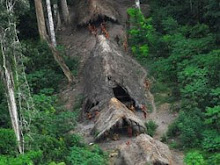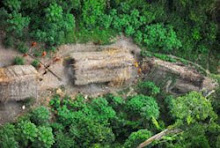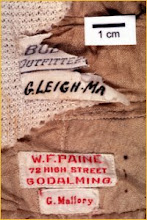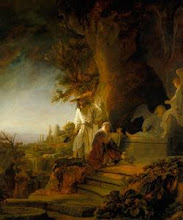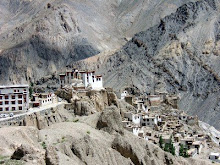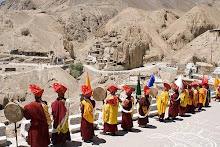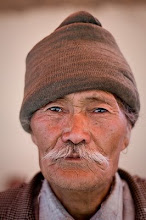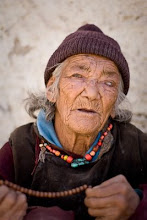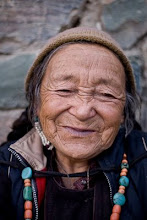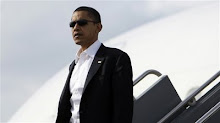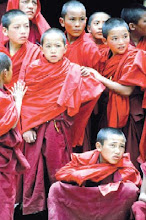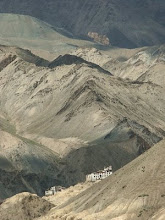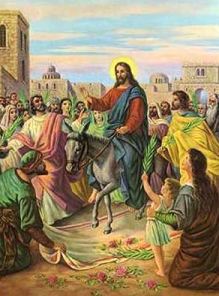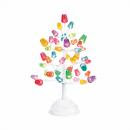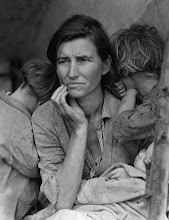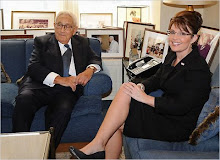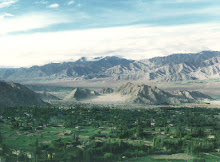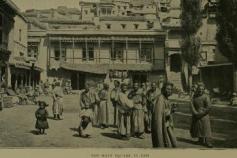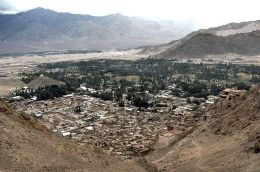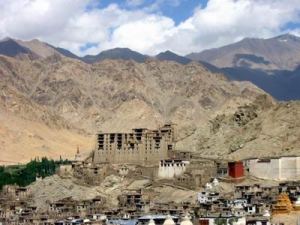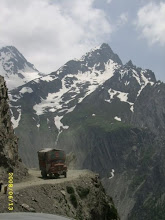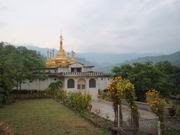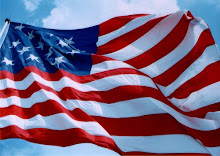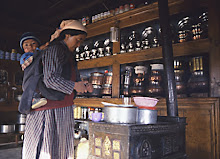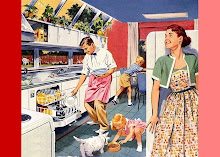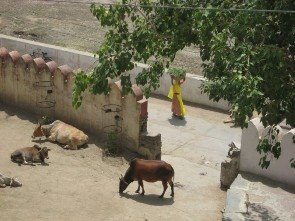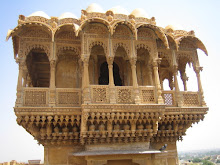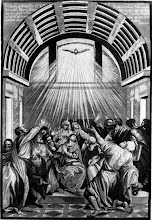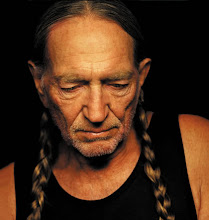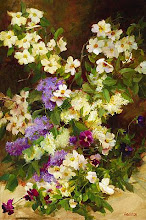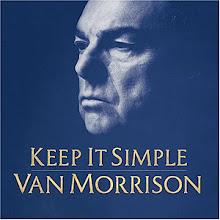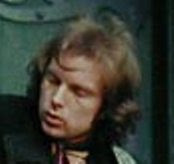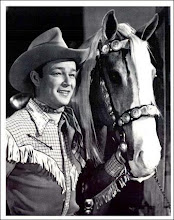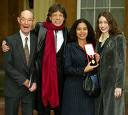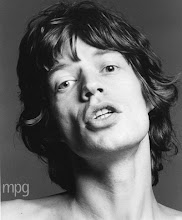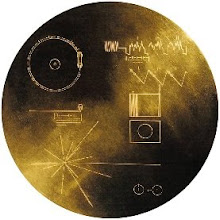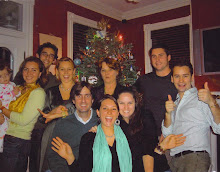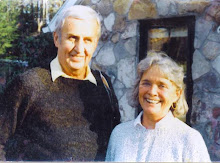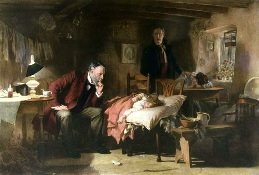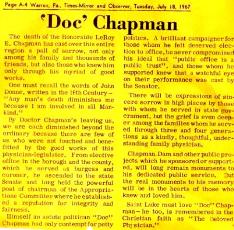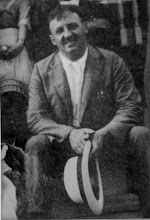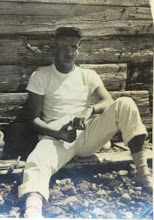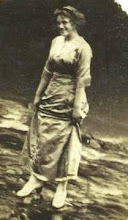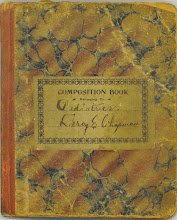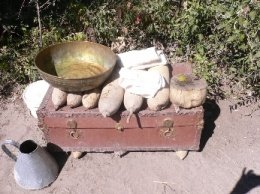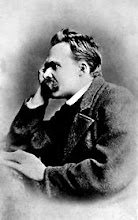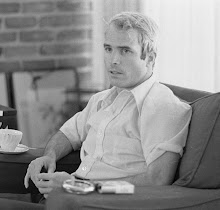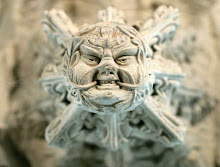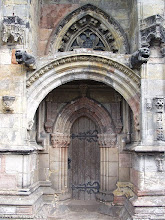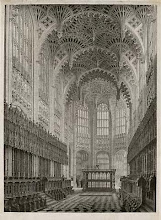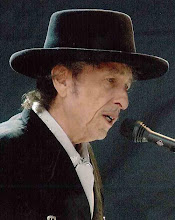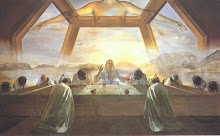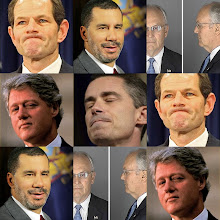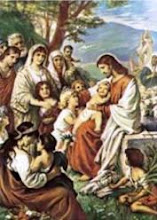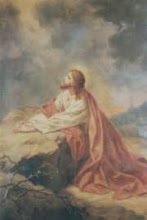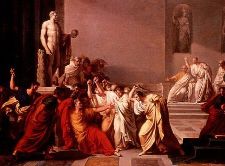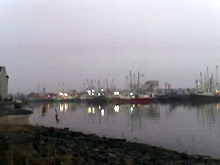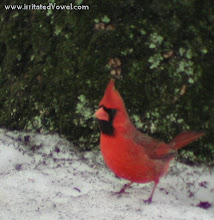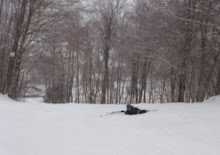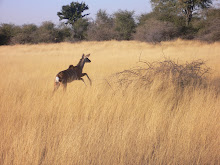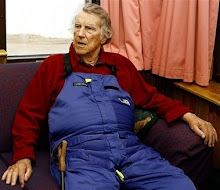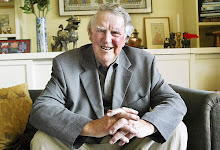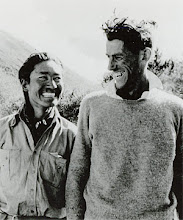I will post Ted Turner's very sweet and unadorned rendition of "Home on the Range" as soon as it's on Youtube.
I love Ted Turner and would go so far as to say I understand him. But that's only thanks to Tom Brokaw's questioning of him tonight on Meet the Press, and casual but steady observations of him through the years. I haven't even read his latest book, "Call Me Ted", but I look forward to it. Maybe I've been bamboozled. I thought before tonight that the conventional wisdom was that he was a jerk. But there's just no way, not based on what I just saw on Meet the Press.
He's no Donald Trump. that's for sure. The Donald lays it all out on the table for show and razzle-dazzle, a really fun snake-oil salesman. Ted Turner is just Ted Turner, laying out only what he wants, and most gently at that. On tonight's show, Mr. Brokaw discussed the troubled relationship Mr Turner had with his father, who never thought his son Ted would amount to anything because he was studying Classics at Brown. Ted answered, barely changing his expression, honestly and forthrightly, that his father's disapproval and subsequent suicide eventually made him a better person. He learned to keep on going and to set his lifetime goals impossibly high so that he would never lose energy or motivation. The man has done so much, and given so generously, to make the world, the WORLD, mind you, a better place. He allowed himself to beam just a little with pride when he talked about giving the U.S. government a bailout when they were "coming up short".
His interesting comment in response to Brokaw's question asking if Putin has kind of "a KGB look" was basically "Hey, they have a KGB, we have an FBI, both respectable organizations." Who knew? But I'd wager Ted Turner knows more about that than I do.
Then Mr. Brokaw read a statement from Jane Fonda about how Ted can't "open himself" to religion or the Holy Spirit. Hogwash! No wonder they couldn't stay married! What could she, with all her ups and downs, insecurities and "right ideas", know for sure about the inner workings of someone so private, humble and steady? (I'm under a spell.)
"Ted Turner!? Humble!?", you say? I'd say yes. In response to Mr. Brokaw's question about whether he prayed, Mr. Turner replied that he prayed for his friends when they were ill, but that he tried to keep the prayers short so as not to clog the airwaves.
And then, at Tom Brokaw's request,and because they are apparently friends, Ted Turner closed by singing one verse a capella, without the chorus, of "Home on the Range." It was lovely.
Sunday, November 30, 2008
Ineffable Experience at Lamayuru
My daughter Honna and I actually saw this happen in Lamayuru! We were there when the photos above were taken. It was not a large group of people, it was a more-or-less private celebration by the monks and local Buddhists to welcome a visitor, a monk supposedly very close in rank to the Dalai Lama. We stood with the group as banners waved and the monks' hauntingly beautiful instruments and horns resounded across the valleys. We watched the progression towards us of the monk, travelling in a caravan of white Jeep-type vehicles toward the monastery. We were not forewarned, and thought we were only visiting for a quick look at the monastery on our way to Domkhar to view the LEHO projects and the Women's Alliance Group. But our host surprised us by asking casually if we would be interested in taking a little detour and visiting Lamayuru. We had tea and soup at a cavernous cafe there at the monastery, and noticed monks tending to instruments and donning robes and headgear casually here and there, as if getting ready to go to a band practice. - (I think some of the cool looking guys in cargo pants and t-shirts who were working in the cafe morphed into the transcendent figures on the mountaintop, all the better)- We barely sensed the growing anticipation at the monastery, because the "vibe" was so cool, calm and collected.
Travels on the Leh-Srinigar Road and Beyond
This is a post from July 08 which I have dug out because it's about my trip with my daughter through Jammu and Kashmir, specifically Ladakh. For some reason it was still in the "edit" column and I apparently never published it to the blog. But in light of recent horrors in Mumbai, which some analysts attribute to disputes over Kashmir, it seems timely to describe some of the beauties of the area which we experienced. If you scroll down to late July and early August (click on "older posts"), there are many photos of this trip, still not 100% organized, but enough to give you a feel for this magnificent part of the world.
~~~~~~~~~~~~~~~~~~~~~~~~~~~~~~~~~~~
Cannot believe the wonderful trip we took with Mr. Tashi from LEHO...the vehicle was small and the LEHO people, Dr. Mohammed Deen and Razia Sultana were so helpful in making the arrangements, which involved helping to transport LEHO-connected people from one town to another. They were all concerned if we would be uncomfortable. "Oh no it'll be fine" I said, little knowing what a full spectrum of comfort levels there are in this world, and in particular along the Leh-Kargil road.....so arduous but so incredible. The engineering feat of creating this wonderful road, with its stone walls, so much of it in excellent shape, is an endeavor most Americans couldn't imagine....the workers live in tents along the way, working for months at a time before taking breaks to go home to their villages.
Everywhere we went the hospitality was so generous, kind, gentle. My photos, if I ever get rested enough to upload them, will confirm the utter beauty of the homes and the hard work the people do with ease and love. We slept in a tent on the top of a Ladakhi roof in the village of Dumkbar. If we would have done any sleepwalking outside the tent we would have fallen off a ledge into oblivion. I usually go to the bathroom several times a night but this was definitely not an option...the toilet would have required a trip down stairs through the home where people were sleeping, and then outside along a narrow path through a garden.I t was what they call a dry toilet which is a hole in the ground. The toilet was not the problem, just the location of it, one misstep in the nighttime could have ended in disaster. At the home we were staying it was very clean, everything was clean and beautiful, shrines and holiness throughout.
The ride was so harrowing and backbreaking I can't believe the fascinating things that happened along the way and the people we met and all that we learned. I would do it all again tomorrow if I had a chance.
Unfortunately Honna's camera memory card of the trip got scratched and so much of it all is lost we think. It's a true heartbreak. But we have to accept it and move on. We still have enough to design the brochure that LEHO needs, since they acknowledge forthrightly their weakness is in written English documentation of their work. They do have a logo but I think it needs help. They appoint the head of their greenhouse projects in each village and then provide materials and training for start-up, but then back off, and let the villagers run it themselves, dropping in now and then to offer help without insulting the pride of the villagers. Everyone profits, and everyone must pay some money into their business, machine repairs etc. We also visited a self-starting children's school that runs for an hour each night, at 7:30 after work is done, just to learn one English word a day. I will look for flash cards with pictures on the baclk to send them. Also it amazes me that they apparently don't grow or know about kale, which loves the winter. so I'm going to send some seeds.... The winters are so hard and these LEHO projects are designed in conjunction with 4 other NGOS to help improve the villagers life.
We just happened to be present at Lamayuru monastery when a new Rimpoche arrived for a visit in a caravan of modern white jeeps.We saw them weaving back and forth across the mountains from a long way off. All the monks played their ancient instruments and wore the ancient ceremionial garb for the arrival, the most ancient Ladakhis and Tibetan refugees in traditional garb spun prayer wheels and sat along the road, waiting for him. I don't know how they have the strength to walk so far and up such hills. We also visited Alchi monastery, absolutely impossible to describe the ancient beauties, efforts, and mysteries there. These monasteries have as much and maybe more spiritual oomph than anywhere I've ever been. When you consider how remote they are, how difficult they are to reach even in 2008, you really do have to wonder how they could build gilded statues of Buddhas encrusted with semi-precious stones two stories high- a thousand years ago!
But most importantly perhaps, we saw the LEHO (NGO) works in progress, microhydroelectric power in action for grinding almonds, extracting the oil, and grinding barley. The community all benefits from each product through a cooperative unit, with the European Union at the top of the pyramid of engineers and donors. No USA support of LEHO to speak of yet, but we will research that and set up a fund for interested donors. Swedish and French very large donors of equipment including weaving looms, spinning and wool carding machines. I bought one shawl that will supposedly support a village for a long time, and empower women to have their own money. Many of the projects are arranged so that the women don't have to ask their husbands for money for household expenses, which is considered to be humiliating.
We were entertained in every household we visited- every greenhouse, every root cellar, every poultry farm, every apricot drying scheme, every garden, by kind gracious, gentle, laughing, happy people, offering us butter tea and regular tea and biscuits and very crunchy almond barley mix...We rode much of the journey with traditionally dressed Ladakhi women, sleeping on one another's shoulders etc as we bumped along.
I hadn't realized the importance of the slight change in altitude and keeping hydrated for the return to Leh, which is higher altitude. Last night I had my first episode of true frightening death-defying pain, getting an hourlong headache in which I thought my brain was exploding. Never in my life experienced such pain, it was beyond belief. Honna did her kind care and pranic healing, and just her kind hand on my brow and to be able to hold onto her arm was such a comfort. I couldn't get out of bed for another twelve hours as it subsided. I thought it was cerebral edema (for which I had brought an emergency supply of predisone but didn't use) but Honna softly and gently said not to worry, it was just lack of proper hydration on our journey. The Ladakhi women don't drink water on their journeys so I was trying to be one of them and not be so American with my water bottle, but I am what I am, and the water is so critical at altitude..you have to drink it all day long from safe water bottles, everyone does, plastic which can be refilled at certain places, but plastic in general is frowned upon in this most ecologically aware part of the world...they put America to shame here in Ladakh, because their ecological schemes are so advanced and so gentle...
On the way back we were nearly out of gas and it was very dark on very windy roads along cliffs. We saw ancient remote statues - gilded and bejewelled- of various deities in the temples along the way. Even though it's only a few hundred kilometers to Dumkbar along the Srinigar-Leh road, it took about eight hours with all our stops along the way. It was a hard and exhausting journey but when we arrived, and sat on a dirt floor by candlelight with the beautiful men and women, looking at their cooperative efforts in handicraft, and drinking butter tea sitting by the looms and woolens and grains, helping to box them up to take to market the next day, it was an ineffably beautiful end to the day. In the car the next day the ever-jolly Ladakhi women took turns grabbing my thigh and shaking it and saying how strong I was and how young I look! I have a hard time accepting compliments, but it is amazing and shocking to get compliments from the people I admire most in the world for their strength and beauty. However life in the mountain villages is hard, and people whose age I estimate as 60 or 70 are actually only in their forties and fifties, but still beautiful beyond words....
I am beyond happy, beyond blessed,beyond wonder, so full of gratitude for this experience....Love to all...Please become aware of Ladakh. Honna and I will be trying to raise awareness in the USA when we return. As I've said, we are responsible now for making a brochure and other literature as part of our arrangement with the NGO LEHO to go to the outer villages and homes.ALthough Leh is a wonderful bustling tourist destination with its share of hustlers and vendors just like any other tourist town, Ladakh is an unspoiled, almost unspoilable region of the world. I haven't been able to upload photos, the time is too long, but no picture could ever capture the pure goodness and beauty of Ladakh.
~~~~~~~~~~~~~~~~~~~~~~~~~~~~~~~~~~~
Cannot believe the wonderful trip we took with Mr. Tashi from LEHO...the vehicle was small and the LEHO people, Dr. Mohammed Deen and Razia Sultana were so helpful in making the arrangements, which involved helping to transport LEHO-connected people from one town to another. They were all concerned if we would be uncomfortable. "Oh no it'll be fine" I said, little knowing what a full spectrum of comfort levels there are in this world, and in particular along the Leh-Kargil road.....so arduous but so incredible. The engineering feat of creating this wonderful road, with its stone walls, so much of it in excellent shape, is an endeavor most Americans couldn't imagine....the workers live in tents along the way, working for months at a time before taking breaks to go home to their villages.
Everywhere we went the hospitality was so generous, kind, gentle. My photos, if I ever get rested enough to upload them, will confirm the utter beauty of the homes and the hard work the people do with ease and love. We slept in a tent on the top of a Ladakhi roof in the village of Dumkbar. If we would have done any sleepwalking outside the tent we would have fallen off a ledge into oblivion. I usually go to the bathroom several times a night but this was definitely not an option...the toilet would have required a trip down stairs through the home where people were sleeping, and then outside along a narrow path through a garden.I t was what they call a dry toilet which is a hole in the ground. The toilet was not the problem, just the location of it, one misstep in the nighttime could have ended in disaster. At the home we were staying it was very clean, everything was clean and beautiful, shrines and holiness throughout.
The ride was so harrowing and backbreaking I can't believe the fascinating things that happened along the way and the people we met and all that we learned. I would do it all again tomorrow if I had a chance.
Unfortunately Honna's camera memory card of the trip got scratched and so much of it all is lost we think. It's a true heartbreak. But we have to accept it and move on. We still have enough to design the brochure that LEHO needs, since they acknowledge forthrightly their weakness is in written English documentation of their work. They do have a logo but I think it needs help. They appoint the head of their greenhouse projects in each village and then provide materials and training for start-up, but then back off, and let the villagers run it themselves, dropping in now and then to offer help without insulting the pride of the villagers. Everyone profits, and everyone must pay some money into their business, machine repairs etc. We also visited a self-starting children's school that runs for an hour each night, at 7:30 after work is done, just to learn one English word a day. I will look for flash cards with pictures on the baclk to send them. Also it amazes me that they apparently don't grow or know about kale, which loves the winter. so I'm going to send some seeds.... The winters are so hard and these LEHO projects are designed in conjunction with 4 other NGOS to help improve the villagers life.
We just happened to be present at Lamayuru monastery when a new Rimpoche arrived for a visit in a caravan of modern white jeeps.We saw them weaving back and forth across the mountains from a long way off. All the monks played their ancient instruments and wore the ancient ceremionial garb for the arrival, the most ancient Ladakhis and Tibetan refugees in traditional garb spun prayer wheels and sat along the road, waiting for him. I don't know how they have the strength to walk so far and up such hills. We also visited Alchi monastery, absolutely impossible to describe the ancient beauties, efforts, and mysteries there. These monasteries have as much and maybe more spiritual oomph than anywhere I've ever been. When you consider how remote they are, how difficult they are to reach even in 2008, you really do have to wonder how they could build gilded statues of Buddhas encrusted with semi-precious stones two stories high- a thousand years ago!
But most importantly perhaps, we saw the LEHO (NGO) works in progress, microhydroelectric power in action for grinding almonds, extracting the oil, and grinding barley. The community all benefits from each product through a cooperative unit, with the European Union at the top of the pyramid of engineers and donors. No USA support of LEHO to speak of yet, but we will research that and set up a fund for interested donors. Swedish and French very large donors of equipment including weaving looms, spinning and wool carding machines. I bought one shawl that will supposedly support a village for a long time, and empower women to have their own money. Many of the projects are arranged so that the women don't have to ask their husbands for money for household expenses, which is considered to be humiliating.
We were entertained in every household we visited- every greenhouse, every root cellar, every poultry farm, every apricot drying scheme, every garden, by kind gracious, gentle, laughing, happy people, offering us butter tea and regular tea and biscuits and very crunchy almond barley mix...We rode much of the journey with traditionally dressed Ladakhi women, sleeping on one another's shoulders etc as we bumped along.
I hadn't realized the importance of the slight change in altitude and keeping hydrated for the return to Leh, which is higher altitude. Last night I had my first episode of true frightening death-defying pain, getting an hourlong headache in which I thought my brain was exploding. Never in my life experienced such pain, it was beyond belief. Honna did her kind care and pranic healing, and just her kind hand on my brow and to be able to hold onto her arm was such a comfort. I couldn't get out of bed for another twelve hours as it subsided. I thought it was cerebral edema (for which I had brought an emergency supply of predisone but didn't use) but Honna softly and gently said not to worry, it was just lack of proper hydration on our journey. The Ladakhi women don't drink water on their journeys so I was trying to be one of them and not be so American with my water bottle, but I am what I am, and the water is so critical at altitude..you have to drink it all day long from safe water bottles, everyone does, plastic which can be refilled at certain places, but plastic in general is frowned upon in this most ecologically aware part of the world...they put America to shame here in Ladakh, because their ecological schemes are so advanced and so gentle...
On the way back we were nearly out of gas and it was very dark on very windy roads along cliffs. We saw ancient remote statues - gilded and bejewelled- of various deities in the temples along the way. Even though it's only a few hundred kilometers to Dumkbar along the Srinigar-Leh road, it took about eight hours with all our stops along the way. It was a hard and exhausting journey but when we arrived, and sat on a dirt floor by candlelight with the beautiful men and women, looking at their cooperative efforts in handicraft, and drinking butter tea sitting by the looms and woolens and grains, helping to box them up to take to market the next day, it was an ineffably beautiful end to the day. In the car the next day the ever-jolly Ladakhi women took turns grabbing my thigh and shaking it and saying how strong I was and how young I look! I have a hard time accepting compliments, but it is amazing and shocking to get compliments from the people I admire most in the world for their strength and beauty. However life in the mountain villages is hard, and people whose age I estimate as 60 or 70 are actually only in their forties and fifties, but still beautiful beyond words....
I am beyond happy, beyond blessed,beyond wonder, so full of gratitude for this experience....Love to all...Please become aware of Ladakh. Honna and I will be trying to raise awareness in the USA when we return. As I've said, we are responsible now for making a brochure and other literature as part of our arrangement with the NGO LEHO to go to the outer villages and homes.ALthough Leh is a wonderful bustling tourist destination with its share of hustlers and vendors just like any other tourist town, Ladakh is an unspoiled, almost unspoilable region of the world. I haven't been able to upload photos, the time is too long, but no picture could ever capture the pure goodness and beauty of Ladakh.
Tuesday, November 18, 2008
Wasting Some Time Staring at the Stars
I was supposed to be in bed already, work tomorrow and all that. But I grabbed a bag of granola and started staring out the windows looking at the stars, and wondering about the universe. WHAT IS IT THAT WE HOPE IS OUT THERE?
I imagined someone like me, light years away, starting to grow old, tired and feeling lazy, holding onto a granola cereal bag and staring at her sky, wondering what her children are doing and whatever happened to the men she loved in her life,,,,munching away and staring at some distant planet that might be earth, and imagining that maybe it's better here,and in her helpless kindness, wishing us well.
I imagined someone like me, light years away, starting to grow old, tired and feeling lazy, holding onto a granola cereal bag and staring at her sky, wondering what her children are doing and whatever happened to the men she loved in her life,,,,munching away and staring at some distant planet that might be earth, and imagining that maybe it's better here,and in her helpless kindness, wishing us well.
Tuesday, November 11, 2008
George Mallory's body: Alabaster on Everest
In May of 1999, when George Mallory's body was discovered frozen into Mt. Everest, the skin of his back gleaming in the sun like alabaster seventy some years after he died, I wrote a poem. I've lost the poem but I remember posting it at www.mountainzone.com, where it was absorbed into the ethers.
I had been feverishly following the Mallory-Irvine Research Expedition online, buying my kids t-shirts in support of the search, and listening with them to the reports broadcast by Eric Simonson from Everest. Conrad Anker made the find, later describing it this way:
" I saw a patch of white, that was whiter than the rock that was around and also whiter and whiter than the snow that was there, and went there. And within a few minutes of being there realized that this wasn't a body from recent times; it was something that had been there for quite awhile..... He seemed to be at peace with himself. He had been there quite awhile, and there was something very, very subtle about his being there, not really scary and violent. "
The photographs of the body were beyond thrilling to me. There's no way to express the poignancy of the image. Mallory's arms reaching upwards, his bleached white body melded to the mountain forever, his earnestness so clear even in death, trailing bits and pieces of wool and cotton clothing still, even a clearly legible name-tag sewn lovingly into his shirt. The thought that his camera might be found, and a statement by the Kodak company that they very well might be able to develop the film, was truly provocative.
How does someone tackle the likes of Mt. Everest, the high odds of death, the altitude, the weather, the strain? What shadows and forces would drive a man from the safe haven of life in Cambridge to the highest and most difficult peak in the world? He and his friend Andrew Irvine succumbed while struggling together to this peak, casting logic aside, the bond between them unfathomable to those of us ordinary mortals who lust only for what's close at hand.
Mallory was famous for responding to a reporter who asked why he wanted to climb Everest: "Because it's there." Reporters continued to ask him variations of the question again and again. "It's of no use", he said. "If you cannot understand that there is something in man which responds to the challenge of this mountain and goes out to meet it, that the struggle is the struggle of life itself upward and forever upward, then you won't see why we go. What we get from this adventure is just sheer joy. And joy is, after all, the end of life".
So to the nice woman who recently asked me what I would take along to India next week to occupy myself, and why in the world I would go to Leh ( a mere 11,000 feet) and the Tibetan plateau, I defer to Mallory, who found it hard to explain, but shut them up by saying "Because it's there."
-repeat from 6-08
Wednesday, November 5, 2008
Oh and By The Way, When I was in northern India, in the Himalayas, this past summer, they were praying for Obama
I can't believe I never told the stories in my blog about how the people I met in remote areas of India this summer were really attuned to the U.S. election. They hoped Obama would win. I was in the Himalayas, northern India, in Jammu and Kashmir, in a particular area where Muslims and Buddhists coexist peacefully. I had always wanted to go there, and I got there as if by magic. That story is well-documented in my earlier posts. I rode in cabs through desert terrains, and a driver would swing his head around to me and ask about Obama, and add hopefully, that he hoped Obama would win. This happened in some of the most remote places on earth.
Once in a jewelry store in Leh, Ladakh, India,near the border of Pakistan and China, I bought a ring, lapus lazuli, for a few dollars more than I should have, ten instead of five, rupees being my downfall. I joked with the store owner, I liked him: you charged me too much. He spoke a little English. He was kind, and funny, as kind and funny as any businessman can be. My daughter and I returned the next day, we struck a bargain, I exchanged one ring for another, he was very nice and very cool. We had a rapport. We laughed together. I told him he should come visit me in the U.S. sometime. He laughed a stoned, shoulder-shaking laugh and said "Are you kidding?! They would never let me into the U.S! I am a Muslim, I am Pakistani! With a name like mine, I could never get a visa into America.!"
And then he winked. Well, maybe someday. Maybe someday when America is ok again.
Once in a jewelry store in Leh, Ladakh, India,near the border of Pakistan and China, I bought a ring, lapus lazuli, for a few dollars more than I should have, ten instead of five, rupees being my downfall. I joked with the store owner, I liked him: you charged me too much. He spoke a little English. He was kind, and funny, as kind and funny as any businessman can be. My daughter and I returned the next day, we struck a bargain, I exchanged one ring for another, he was very nice and very cool. We had a rapport. We laughed together. I told him he should come visit me in the U.S. sometime. He laughed a stoned, shoulder-shaking laugh and said "Are you kidding?! They would never let me into the U.S! I am a Muslim, I am Pakistani! With a name like mine, I could never get a visa into America.!"
And then he winked. Well, maybe someday. Maybe someday when America is ok again.
Subscribe to:
Comments (Atom)









